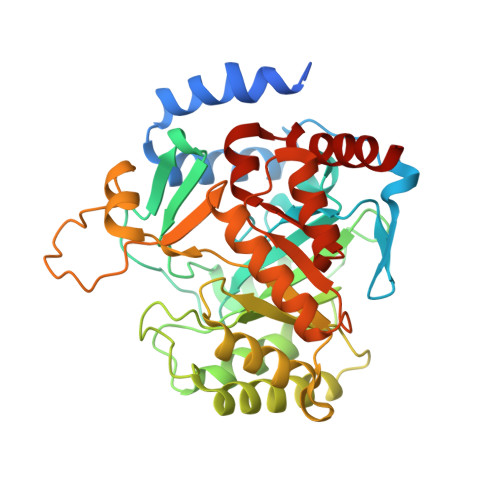Structural basis for the function and inhibition of dihydroorotate dehydrogenase from Schistosoma mansoni.
de Mori, R.M., Aleixo, M.A.A., Zapata, L.C.C., Calil, F.A., Emery, F.S., Nonato, M.C.(2021) FEBS J 288: 930-944
- PubMed: 32428996
- DOI: https://doi.org/10.1111/febs.15367
- Primary Citation of Related Structures:
6UY4 - PubMed Abstract:
Schistosomiasis is a serious public health problem, prevalent in tropical and subtropical areas, especially in poor communities without access to safe drinking water and adequate sanitation. Transmission has been reported in 78 countries, and its control depends on a single drug, praziquantel, which has been used over the past 30 years. Our work is focused on exploiting target-based drug discovery strategies to develop new therapeutics to treat schistosomiasis. In particular, we are interested in evaluating the enzyme dihydroorotate dehydrogenase (DHODH) as a drug target. DHODH is a flavoenzyme that catalyzes the stereospecific oxidation of (S)-dihydroorotate (DHO) to orotate during the fourth and only redox step of the de novo pyrimidine nucleotide biosynthetic pathway. Previously, we identified atovaquone, used in the treatment of malaria, and its analogues, as potent and selective inhibitors against Schistosoma mansoni DHODH (SmDHODH). In the present article, we report the first crystal structure of SmDHODH in complex with the atovaquone analogue inhibitor 2-((4-fluorophenyl)amino)-3-hydroxynaphthalene-1,4-dione (QLA). We discuss three major findings: (a) the open conformation of the active site loop and the unveiling of a novel transient druggable pocket for class 2 DHODHs; (b) the presence of a protuberant domain, only present in Schistosoma spp DHODHs, that was found to control and modulate the dynamics of the inhibitor binding site; (c) a detailed description of an unexpected binding mode for the atovaquone analogue to SmDHODH. Our findings contribute to the understanding of the catalytic mechanism performed by class 2 DHODHs and provide the molecular basis for structure-guided design of SmDHODH inhibitors. DATABASE: The structural data are available in Protein Data Bank (PDB) database under the accession code number 6UY4.
- Laboratório de Cristalografia de Proteínas, Faculdade de Ciências Farmacêuticas de Ribeirão Preto, Universidade de São Paulo, Ribeirão Preto, Brazil.
Organizational Affiliation:


















